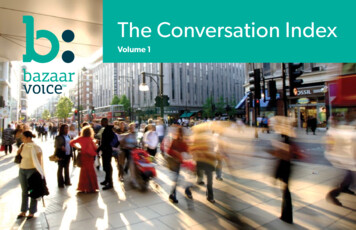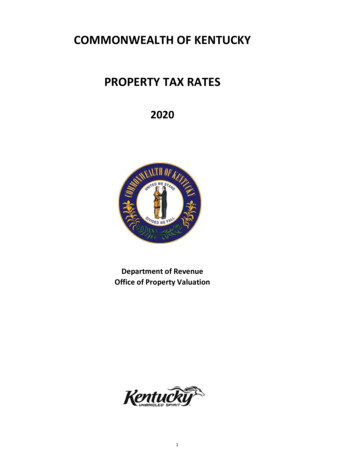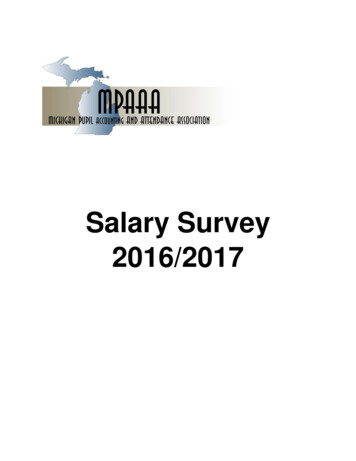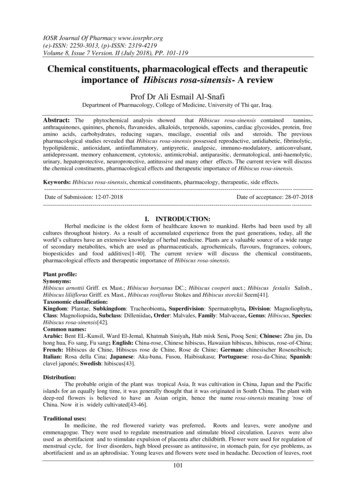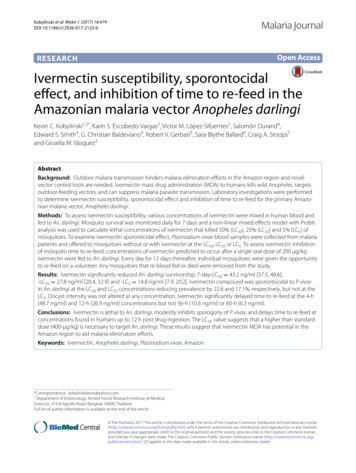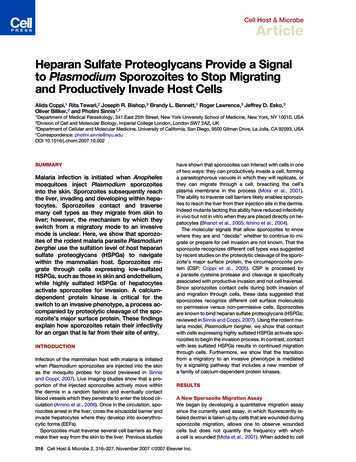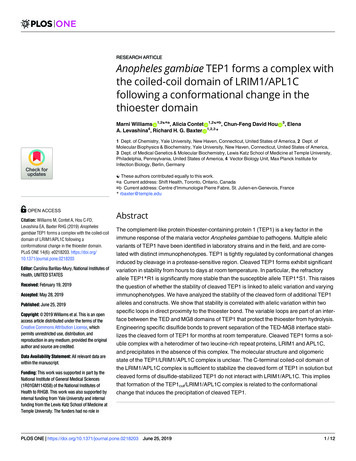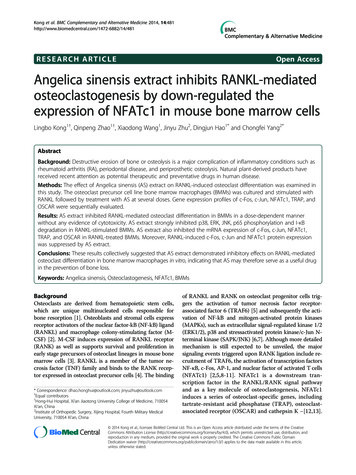
Transcription
PLOS ONERESEARCH ARTICLEAssociation of Anopheles sinensis averageabundance and climate factors: Use ofmosquito surveillance data in Goyang, KoreaJin Young Jang1, Byung Chul Chun ID1,2*1 Department of Public Health, Korea University Graduate School, Seoul, Korea, 2 Department of PreventiveMedicine, Korea University College of Medicine, Seoul, Korea* 1111111a1111111111a1111111111OPEN ACCESSCitation: Jang JY, Chun BC (2020) Association ofAnopheles sinensis average abundance and climatefactors: Use of mosquito surveillance data inGoyang, Korea. PLoS ONE 15(12): 479Editor: Jeffrey Shaman, Columbia University,UNITED STATESReceived: January 6, 2020Accepted: December 10, 2020Published: December 28, 2020Copyright: 2020 Jang, Chun. This is an openaccess article distributed under the terms of theCreative Commons Attribution License, whichpermits unrestricted use, distribution, andreproduction in any medium, provided the originalauthor and source are credited.Data Availability Statement: All relevant data arewithin the manuscript and its Supportinginformation files.Funding: The author(s) received no specificfunding for this work.Competing interests: The authors have declaredthat no competing interests exist.Malaria is a vector-borne disease transmitted by Anopheline mosquitoes. In Korea, Plasmodium vivax malaria is an endemic disease and the main vector is Anopheles sinensis. Plasmodium vivax malaria is common in the northwestern part of South Korea, including in thecity of Goyang in regions near the demilitarized zone. This study aimed to identify the besttime-series model for predicting mosquito average abundance in Goyang, Korea. Mosquitodata were obtained from the Mosquito Surveillance Program of the Goyang IlsanseoguPublic Health Center for the period 2008–2012. Black light traps were set up periodically ina park, a senior community center, and a village community center, public health center,drainage pumping station, cactus research center, restaurant near forest, in which manyactivities occur at night. In total, 9,512 female mosquitoes were collected at 12 permanenttrapping sites during the mosquito season in the study period. Weekly An. sinensis averageabundance was positively correlated with minimum grass temperature (r 0.694, p 0.001), precipitation (r 0.326, p 0.001). The results showed that seasonal autoregressiveintegrated moving average (SARIMA) (1,0,0)(0,0,1)21 with minimum grass temperature variable at time lag0 weeks and the precipitation variable at time lag1 weeks provided that bestmodel of mosquito average abundance. The multivariate model accounted for about 54.1%of the mosquito average abundance variation. Time-series analysis of mosquito averageabundance and climate factors provided basic information for predicting the occurrence ofmalaria mosquitoes.IntroductionMalaria is a vector-borne disease transmitted by Anopheline mosquitoes [1] and caused byparasites of the genus Plasmodium (P. vivax, P. falciparum, P. ovale, P. malariae). The WorldHealth Organization estimated that 219 million clinical episodes (95% confidence interval[CI]; 203–262 million) occurred in 2017 [2]. Korea was considered to be a malaria-free regionafter two cases in 1984, but Plasmodium vivax malaria has re-emerged in Paju (near the Demilitarized Zone), Gyeonggi Province, following one case in a Korean Army soldier in 1993 [3].PLOS ONE https://doi.org/10.1371/journal.pone.0244479 December 28, 20201 / 11
PLOS ONEMosquito abundance and climate factors in KoreaAfter 1993, it peaked at 4,142 cases in 2000. The trend decreased between 2008 (1,052 cases)and 2012 (542 cases). Until recently, endemic malaria cases remained almost constant (mean;586.43, sd; 90.177) [4, 5]. The major malaria transmitting mosquitoes in Korea, genus Anopheles, are distributed in all parts of Asia, such as China and Japan. There are known 8 species ofgenus Anopheles and the main dominant species is Anopheles sinensis (Wiedemann) [3, 6].Plasmodium vivax malaria commonly occurs in the northwestern part of the South Korea,including in the city of Goyang in regions near the demilitarized zone (DMZ) [7]. The KoreaCenters for Disease Control and Prevention selects an area with at least one patient in the previous year as a malaria-risk area, and this is the case of Goyang [3]. In Korea, there has been norapid increase in the incidence of malaria in recent years, but there is potential for epidemicbecause of the uncontrolled geographic location near DMZ.Vector-borne diseases are very sensitive to climate change. Mosquitoes are ectothermicinsects that pass through three aquatic juvenile stages (eggs, larvae, and pupae). Additionally,malarial parasites undergo a development phase in the mosquito. Therefore, mosquito averageabundance and climate factors are important determinants of malaria transmission [8, 9].Previous studies have indicated that temperature, relative humidity, and precipitation arecorrelated with An. sinensis average abundance. In Korea, the monthly average temperatureand monthly amount of precipitation were significantly correlated with average abundance ofmosquitoes on Jeju Island [10]. In China, mosquito average abundance was significantly correlated with the monthly average temperature (r 0.359, p 0.05) and monthly average relativehumidity (r 0.850, p 0.05) at the Three Gorges Reservoir; with the monthly average temperature (r 0.958, p 0.001), monthly average relative humidity (r 0.746, p 0.005), andmonthly average precipitation (r 0.725, p 0.008) at Ningbo city; and the daily average relative humidity (r 0.859, p 0.029) at Yongcheng city [11–13].Through these previous studies, we assumed that there was a strong association betweenAn. sinensis average abundance and climate factors; therefore, we applied a time-series seasonal autoregressive integrated moving average (SARIMA) model for An. sinensis averageabundance prediction in Goyang, Korea. However, the meteorological factors that affectmosquito average abundance may vary by latitude or region, and little research has been performed in Korea, where malaria is prevalent only in the northern region close to the DMZ.In this study, we aimed to identify the association of using climate factors as independentvariables for Plasmodium vivax malaria mosquito average abundance in Goyang, Korea,through a 5-year cross-sectional study to find the best model for predicting mosquito averageabundance to inform vector control for malaria.Materials and methodsStudy areaGoyang (37 34 –37 44 N, 126 40 –126 59 E) is a city in Gyeonggi Province in the northwestof South Korea. It is adjacent to Seoul and downstream of the Han River, and comprises anarea of 268.05 km2, with three districts (Ilsandong-gu, Ilsanseo-gu, Deogyang-gu). It has a population of over 1 million individuals [14]. Korea has a temperate climate, is influenced by theEast Asian monsoon, and has four distinct seasons (spring, summer, autumn, and winter).The average annual rainfall is around 1,300 mm, and is especially heavy in July and Augustbecause of a short rainy season and the occurrence of typhoons [15].Data sourceMosquito data were obtained from the Mosquito Surveillance Program of the Goyang Ilsanseogu Public Health Center for the period 2008–2012. Monitoring data was collected fivePLOS ONE https://doi.org/10.1371/journal.pone.0244479 December 28, 20202 / 11
PLOS ONEMosquito abundance and climate factors in Koreatimes a week from 2008 to 2012 and three times a week in 2013 (excluding public holidays).Due to differences in collection frequency, mosquito average abundance was standardized tothe mean number of females per trap per night per week.Black light traps were set up periodically in a park, a senior community center, and a villagecommunity center, in which many activities occur at night. Black light trap (model ‘BlackHole’ by BioTrap, http://www.bio-trap.com) is a device that attracts mosquitoes through lightgenerated from UV lamps and carbon dioxide generated by the catalysis of titanium dioxide(TiO2), and the built-in suction fan captures the mosquitoes. Traps were installed at 12 sites(Fig 1) and were operated from 7 p.m. to 6 a.m. throughout the mosquito season. The mosquito season lasts approximately 20 weeks from June to October. We used the data with a continuous time series with a cycle of 21 weeks, there are up to 31–32 weeks intervals between lastand first collection between years.Mosquito classification was performed after freezing at -20 C for 1 day. Mosquitos wereidentified by morphology, and at a species level according to the manual of Korea Centers forDisease Control and Prevention [16].Climate data from the Korea Meteorological Administration were used in our study [17].Independent variables included mean temperature ( C), maximum temperature ( C), minimum temperature ( C), minimum grass temperature ( C), surface temperature ( C), dailytemperature range ( C), duration of sunshine (h), relative humidity (%), minimum relativehumidity (%), precipitation (mm), mean wind speed (m/s), maximum wind speed (m/s), andmaximum instantaneous wind speed (m/s).It is an open national mosquito surveillance system. No specific permissions were requiredfor this mosquito surveillance activities in this Goyang area by the public health center. The firstauthor participated directly in the data collection and analysis as a public health officer workingfor this area. We confirm that this field study did not involve endangered or protected species.Statistical analysisMosquito average abundance and climate data were summarized as the means and standarddeviations obtained over 5 years based on 23–43 weeks per year. Time series plots were used toFig 1. Locations of black light traps at 12 sites in Goyang, Korea, 2008–2012 (copyright map: .org/10.1371/journal.pone.0244479.g001PLOS ONE https://doi.org/10.1371/journal.pone.0244479 December 28, 20203 / 11
PLOS ONEMosquito abundance and climate factors in Koreapresent the distribution of mosquito average abundance and climatic factors. Spearman correlation analysis was performed to identify linear relationships between the various variables.Before carrying out the time series analysis, the distribution of the data was graphicallyexplored in a histogram. Then, the degree of variance, trend, and seasonality were confirmedusing a time-series plot. Season length in the time series was 21 cycles for a total of 105 weeks.Cross-correlation analysis was performed to determine the degree and direction of the relationship between the two variables, and the maximum time lag was 7 previous weeks considering the survival period of mosquitoes. Using the cross-correlation method, we identifiedsignificant time lags between mosquito average abundance and climate factors. Significanttime lags of climate variables were confirmed through the cross-correlation function plot andfitted as independent variables to the predictive model.In general, there are three steps in using a seasonal autoregressive integrated moving average (SARIMA) model: Identification, estimation and diagnostic checking [18]. The first step isto look at the patterns of autocorrelation function (ACF) plot and partial autocorrelation function (PACF) plot and to identify preliminary values of order. The parameter estimates areobtained from the maximum likelihood estimation method. The diagnostic checking involvesperforming the Ljung-Box test to identify the independence of the residuals. In our study, themodel with the smallest value of Bayesian information criterion (BIC) is judged as the mostappropriate one. The structure of the SARIMA model followed the standard form, (p,d,q)(P,D,Q)s, where p is the order of autoregression; d, the degree of differencing; q, the order of themoving average; P, the seasonal autoregression; D, the degree of seasonal differences; Q, theseasonal moving average; and s, the seasonal period. Multivariate time series analysis was carried out using climate variables as valid independent variables. The model was fitted with allpossible combinations of the climate variables with significant lag time obtained throughcross-correlation analysis, through a step-wise procedure, and a model with both low Bayesianinformation criterion (BIC) and high R-square values was selected as the final model. Statistical analyses were performed using SPSS version 21.0 (SPSS Inc, Chicago, IL) and significancewas determined at a p-value 0.05.ResultsIn total, 9,512 mosquitoes were collected from twelve permanent trapping sites during thestudy period in the mosquito season in 2008–2012 (Table 1). The average number of femalemosquitoes captured per trap per night was 7.55 (SD; 10.38), ranging from 0 to 70.7. Weeklymean temperature, minimum grass temperature, and precipitation were 21 C (SD; 4.63),14.9 C (SD; 6.49), and 8.7 mm (SD; 13.57), respectively (Table 2).The mosquito average abundance peaked at 42.83 in week 34 of 2008; 70.67 in week 34 of2009; 15.42 in week 33 of 2010; 15.33 in week 35 of 2011; and 22.83 in week 34 of 2012 (Fig 2).Table 1. Total number of Anopheles sinensis collected by black light traps at 12 sites in Goyang, Korea, during theperiod from 23 to 43 weeks in 2008–2012 (n 9,512).YearMosquitoes, .0244479.t001PLOS ONE https://doi.org/10.1371/journal.pone.0244479 December 28, 20204 / 11
PLOS ONEMosquito abundance and climate factors in KoreaTable 2. Distribution of weekly data on Anopheles sinensis average abundance and climate factors in Goyang, Korea, during the period from 23 to 43 weeks in2008–2012.Weekly dataMosquito average 0.7Climate factorsMean temperature ( Minimum temperature ( C)16.65.590.813.117.92124.1Minimum grass temperature ( C)14.96.49-1.610.616.920.123.5Surface temperature ( C)24.45.228.820.825.628.133.4Daily temperature range ( C)10.32.733.98.310.312.116.2Duration of sunshine (h)5.72.430.245.57.710.7Relative humidity (%)80.37.0455.576.480.48596.6Minimum relative humidity (%)52.113.1822.442.850.66188.7Precipitation (mm)8.713.5700.52.410.985.3Mean wind speed (m/s)1.40.320.91.21.41.62.3Maximum wind speed (m/s)3.60.472.53.33.63.94.8Maximum instantaneous wind speed (m/s)6.50.944.55.86.57.19.3Maximum temperature ( C)SD: standard deviation; Min: minimum; P: percentile; Max: 79.t002Relationships were identified between climate factors and mosquito average abundance.The results of the Spearman correlation analysis to select the primary parameters to fit themodel among the climate variables are as follows. Anopheles sinensis average abundance waspositively correlated with minimum grass temperature (r 0.694, p 0.001), minimumtemperature (r 0.682, p 0.001), mean temperature (r 0.681, p 0.001), surface temperature (r 0.593, p 0.001), maximum temperature (r 0.591, p 0.001). minimum relativehumidity (r 0.509, p 0.001), relative humidity (r 0.364, p 0.001), precipitation(r 0.326, p 0.001), and mean wind speed (r 0.255, p 0.009). Mosquito average abundance was negatively correlated with the daily temperature range (r -0.535, p 0.001) andthe duration of sunshine (r -0.239, p 0.014). There was no significant relationship betweenmosquito average abundance and maximum wind speed (r 0.042, p 0.67) or maximuminstantaneous wind speed (r 0.111, p 0.26) (Table 3).Cross-correlation analysis was performed to identify a significant time lag for all climatefactors (S1 Dataset). Then, those variables were sequentially fit on SARIMA (1,0,0)(0,0,1)21.Anopheles sinensis average abundance and climate factors were fit to three models (Table 4).Model 0, the null model, did not fit the climate variables and was statistically significant atautoregression 1 and seasonal moving average 1. In the model, the residual variance was 0.945and the R-square value was 0.44. Model 1, the best fitting univariate model, fit the minimumgrass temperature variable with a lag of 0 weeks as an independent variable. The residual variance was 0.977 and the R-square value was 0.479. Model 2, the best fitting multivariate model,fit the minimum grass temperature variable with a lag of 0 weeks and the precipitation variablewith a lag of 1 week as an independent variable. The residual variance was 0.96 and the Rsquare value was 0.541 (Fig 3).DiscussionIn this study, we identified relationships between An. sinensis average abundance and climatefactors during mosquito seasons (23–43 weeks, 2008–2012) in Goyang, Korea. In a multivariatePLOS ONE https://doi.org/10.1371/journal.pone.0244479 December 28, 20205 / 11
PLOS ONEMosquito abundance and climate factors in KoreaFig 2. Time series plots of weekly Anopheles sinensis average abundance from 2008 to 2012 in Goyang, Korea. A:Mosquito average abundance, B: Air temperature ( C), C: Ground temperature ( C), D: Daily temperature range ( C),E: Duration of sunshine (h), F: Relative humidity(%), G: Precipitation (mm), H: wind speed .g002PLOS ONE https://doi.org/10.1371/journal.pone.0244479 December 28, 20206 / 11
PLOS ONEMosquito abundance and climate factors in KoreaTable 3. Spearman’s correlations between Anopheles sinensis average abundance and climate factors in Goyang, Korea, from 23 to 43 weeks in maxTminTgrassTmean0.681 –Tmax0.591 0.916 –Tmin0.682 0.971 0.819 –Tgrass0.694 0.946 0.781 0.988 –Tsurface0.593 0.891 0.952 0.805 0.766 Tsurface-0.535 -0.684 -0.391 -0.813 -0.835 -0.426 DS-0.239 -0.293 RHRHmin0.364 0.490 0.509 -0.450 -0.487 0.210 0.6650.362 0.627 0.656 0.795 0.818 DSRHRHminPrecipitationWSmean WSmax–DTR0.027DTR–0.801 -0.006–-0.780 -0.742 0.179 0.383-0.967 – 0.878 0.649 0.759 07-0.735-0.688WSmean0.255 0.245 0.1550.274 0.284 0.210 -0.324 -0.134-0.0400.260 0.351 8-0.1090.1280.303 0.829 –WSinstantaneous0.1110.1730.0440.222 0.218 0.097-0.289 -0.232 0.0680.264 0.381 0.757 0.889 –Bold values indicate statistically significant differences (ie, : p 0.05; : p 0.001).Tmean: mean temperature; Tmax: maximum temperature; Tmin: minimum temperature; Tgrass: minimum grass temperature; Tsurface: surface temperature; DTR:daily temperature range; DS: duration of sunshine; RH: relative humidity; RHmin: minimum relative humidity; WSmean: mean wind speed; WSmax: maximum windspeed; WSinstantaneous: maximum instantaneous wind .t003model with the minimum grass temperature variable at a lag of 0 weeks, and the precipitationvariable at a lag of 1 week, approximately 54.1% of An. sinensis average abundance variationwas explained.The minimum grass temperature is the lowest temperature reached overnight by a thermometer touching short turf, which is measured at 25–50 mm above the ground and is knownas ground frost. Unlike minimum grass temperature, air temperature is measured at 1.25–2 mabove the ground [19]. A limited number of studies have investigated the relationship betweenvector-borne diseases and grass temperature. West Nile virus vector number was positivelycorrelated with grass temperature range (r 0.418, p 0.003) by Pearson correlation analysisin Cook County, USA. Furthermore, maximum grass temperature was found to be a potentialpredictor in regression models [20]. In our study, there was a positive correlation with minimum grass temperature (r 0.694, p 0.001) and a predictor variable in SARIMA model.Table 4. Multivariate seasonal ARIMA models for Anopheles sinensis average abundance and climate factors in Goyang, Korea, 2008–2012.Model 0Model 1Model 2CoefficientSEp valueCoefficientSEp valueCoefficientSEp value0.5750.082 0.0010.4910.088 0.0010.5830.081 007Minimum grass temperature lag ion lag 1–––––0.1780.048 0.001Autoregression 1Seasonal moving average 10.9456.796–Ljung-Box 354.1610.960SE: standard error; BIC: Bayesian information 4479.t004PLOS ONE https://doi.org/10.1371/journal.pone.0244479 December 28, 20207 / 11
PLOS ONEMosquito abundance and climate factors in KoreaFig 3. Fitted values of model and observed values for Anopheles sinensis average abundance in Goyang, Korea, 2008–2012. a: Model 0, b:Model 1 c: Model 3Mosquitoes are ectothermic insects, whose body temperature relies on external heatsources, such as ambient temperature. Temperature plays an important role in the survivalrate of adult mosquitoes and the mortality rate of the juvenile stage [9]. Furthermore, the mainhabitat of mosquitoes is forests, wetlands, tall grasses, weeds, and ground. Also, the immaturestages of mosquitoes need water habitats. The small pools of water created by the rains provides habitat for eggs, lavas and pupas to develop. Excess precipitation may reduce mosquitoabundance through flushing effect. However, the number and size of breeding habitats generally associated with the amount of precipitation [21]. Therefore, given these relationshipsbetween temperature, precipitation, and mosquito biology, it is not surprising that grasstemperature and precipitation were important predictors of An. sinensis average abundance.The present study was not without limitations. We collected mosquito data at 12 sites inGoyang, Korea. Our study collected mosquitoes in urban areas where there are many nightactivities of people, not near cowsheds or pigstys. An. sinensis was attracted to cows, pigs andPLOS ONE https://doi.org/10.1371/journal.pone.0244479 December 28, 20208 / 11
PLOS ONEMosquito abundance and climate factors in Koreadogs more than humans [22]. Also, mosquito collection may be affected near tump or streams.So, to reduce the spatial variability, we standardized to mosquito average abundance, not thenumber of mosquitoes. Morphological identification of An. sinensis is very difficult. Therefore,other Anophelines species (An. belenrae, An. pullus, and An. lesteri,) may have been incorrectlyidentified in this study as An. sinensis. The use of molecular biological methods could be helpimprove the accuracy of mosquito identification. The statistical analysis method we used, SARIMA analysis, has the advantage of making a prediction model even if there are not manyparameters. However, only linear associations between independent and dependent variablescan be used. Therefore, if there is a non-linear relationship between mosquito average abundance and climate variables, the corresponding analysis should be conducted.It is difficult to accurately forecast that the distribution of adult mosquito abundance. However, predicting future values from past values can improve public health plans. This epidemiological information will be helpful in identifying vector control in place and time and raisinglocal community administrator awareness of potential risk.Knowledge on the seasonal distribution of mosquitoes provides information about trendsand seasonality, allowing the identification of potential high-risk regions for malaria. Timeseries analysis of mosquito average abundance and climate factors provides basic informationfor predicting the occurrence of malaria mosquito.ConclusionsIn summary, we found that An. sinensis average abundance was associated with climatic factors in Goyang between 2008 and 2012. The average abundance of mosquito was significantlycorrelated with the temperature, daily temperature range, duration of sunshine, relativehumidity, precipitation, and wind speed at specific time lags. Among these climate variables,grass temperature at time lag0 week and precipitation at time lag1 weeks were fitted the bestmultivariate model. In this modeling study, climatic variables account for 54.1% of the variance in mosquito average abundance. In addition, our results supported that climatic factorsmay be important for predicting the occurrence of malaria vectors.Supporting informationS1 Dataset.(XLSX)S2 Dataset.(XLSX)S3 Dataset.(XLSX)Author ContributionsConceptualization: Jin Young Jang, Byung Chul Chun.Data curation: Jin Young Jang.Formal analysis: Jin Young Jang.Investigation: Jin Young Jang, Byung Chul Chun.Methodology: Jin Young Jang, Byung Chul Chun.Project administration: Byung Chul Chun.PLOS ONE https://doi.org/10.1371/journal.pone.0244479 December 28, 20209 / 11
PLOS ONEMosquito abundance and climate factors in KoreaSupervision: Byung Chul Chun.Validation: Byung Chul Chun.Visualization: Jin Young Jang.Writing – original draft: Jin Young Jang.Writing – review & editing: Jin Young Jang, Byung Chul Chun.References1.Kiszewski A, Mellinger A, Spielman A, Malaney P, Sachs SE, Sachs J. A global index representing thestability of malaria transmission. Am J Trop Med Hyg. 2004; 70: 486–498. PMID: 151559802.Organization WH. World malaria report 2018. Geneva: World Health Organization; 2018. Licence: CCBY-NC-SA. 2018;3.3.Korea Centers for Disease Control and Prevention. Malaria management guidelines. Osong: KoreaCenters for Disease Control and Prevention; 2019.4.Bahk YY, Lee H-W, Na BK, Kim J, Jin K, Hong YS, et al. Epidemiological characteristics of re-emergingvivax malaria in the Republic of Korea(1993–2017). Korean J Parasitol. 2018; 56(6): 531–543. https://doi.org/10.3347/kjp.2018.56.6.531 PMID: 306302735.Korea Centers for Disease Control and Prevention. http://www.cdc.go.kr/npt. Accessed 12 April 2020.6.Foley DH, Klein TA, Kim HC, Kim MS, Wilkerson RC, Li C, et al. Seasonal dynamics of Anopheles species at three locations in the Republic of Korea. J Vector Ecol. 2017; 42(2):335–48. https://doi.org/10.1111/jvec.12274 PMID: 291252417.Park J-W, Jun G, Yeom J-S. Plasmodium vivax malaria: status in the Republic of Korea followingreemergence. Korean J Parasitol. 2009; 47(Suppl): S39. https://doi.org/10.3347/kjp.2009.47.S.S39PMID: 198853348.Medlock JM, Leach SA. Effect of climate change on vector-borne disease risk in the UK. Lancet InfectDis. 2015; 15: 721–730. https://doi.org/10.1016/S1473-3099(15)70091-5 PMID: 258084589.Beck-Johnson LM, Nelson WA, Paaijmans KP, Read AF, Thomas MB, Bjørnstad ON. The effect of temperature on Anopheles mosquito population dynamics and the potential for malaria transmission. PLoSOne. 2013; 8: e79276. https://doi.org/10.1371/journal.pone.0079276 PMID: 2424446710.Lee SH, Nam KW, Jeong JY, Yoo SJ, Koh Y-S, Lee S, et al. The effects of climate change and globalization on mosquito vectors: evidence from Jeju Island, South Korea on the potential for Asian tiger mosquito (Aedes albopictus) influxes and survival from Vietnam rather than Japan. PLoS One. 2013; 8:e68512. https://doi.org/10.1371/journal.pone.0068512 PMID: 2389431211.Duo-quan W, Lin-hua T, Heng-hui L, Zhen-cheng G, Xiang Z. Application of structural equation modelsfor elucidating the ecological drivers of Anopheles sinensis in the three gorges reservoir. PLoS One.2013; 8: e68766. https://doi.org/10.1371/journal.pone.0068766 PMID: 2393588712.Zhao X, Zhang J, Dong H, Zhang T, Bian G, Sun Y, et al. Epidemiological characteristics of malaria inNingbo City, China 2000–2011. Trop Biomed. 2013; 30: 267–276. PMID: 2395949213.Liu X-B, Liu Q-Y, Guo Y-H, Jiang J-Y, Ren D-S, Zhou G-C, et al. The abundance and host-seekingbehavior of culicine species (Diptera: Culicidae) and Anopheles sinensis in Yongcheng city, people’sRepublic of China. Parasit Vectors. 2011; 4: 221. https://doi.org/10.1186/1756-3305-4-221 PMID:2211532014.Goyang City. http://www.goyang.go.kr/www/www05/www05 1/www05 1 1.jsp#. Accessed 12 April2020.15.Korea Meteorological Administration. http://www.kma.go.kr/eng/biz/climate 01.jsp. Accessed 12 April2020.16.Korea Centers for Disease Control and Prevention. Major infectious diseases mediated mosquito control management guidelines. Osong: Korea Centers for Disease Control and Prevention; 2012.17.Korea Meteorological Administration. http://www.weather.go.kr/weather/climate/past tendays.jsp.Accessed 21 November 2019.18.Box GE, Jenkins GM. Time series analysis: Forecasting and control San Francisco. Calif:Holden-Day.1976.19.Jarraud M. Guide to meteorological instruments and methods of observation (WMO-No. 8). WorldMeteorological Organisation: Geneva, Switzerland. 2008. World Meteorological Organization. 2008.PLOS ONE https://doi.org/10.1371/journal.pone.0244479 December 28, 202010 / 11
PLOS ONEMosquito abundance and climate factors in Korea20.Liu H, Weng Q. An examination of the effect of landscape pattern, land surface temperature, and socioeconomic conditions on WNV dissemination in Chicago. Environ Monit Assess. 2009; 159: 6 PMID: 1910756621.Bomblies A. Modeling the role of rainfall patterns in seasonal malaria transmission. Clim Change 2012;112(3–4):673–85.22.Ree H-I. Studies on Anopheles sinensis, the vector species of vivax malaria in Korea. The Korean Journal of Parasitology. 2005; 43(3):75. https://doi.org/10.3347/kjp.2005.43.3.75 PMID: 16192749PLOS ONE https://doi.org/10.1371/journal.pone.0244479 December 28, 202011 / 11
using a time-series plot. Season length in the time series was 21 cycles for a total of 105 weeks. Cross-correlation analysis was performed to determine the degree and direction of the rela-tionship between the two variables, and the maximum time lag was 7 previous weeks consider-ing the survival period of mosquitoes.

